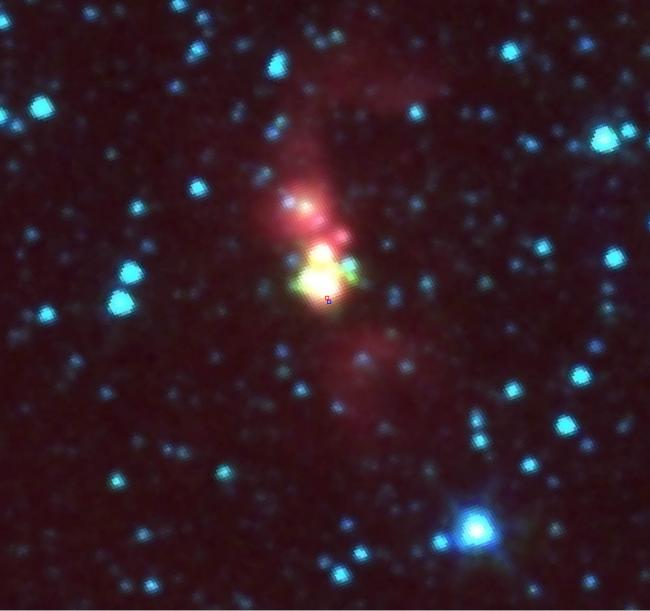
An infrared image taken by the IRAC camera of the young star forming cloud region AGAL313.576+0.324. Regions nominally like this one are known for emitting an infrared line of ionized carbon atom, the result of the ultraviolet light from new stars, however the precise mechanisms are incompletely understood and in extragalactic sources the strength of this line is unpredictable. In a new study of ionized carbon emission in the Milky Way, astronomers found that this particular source stood out for its showing no signs of ionized carbon.
The carbon atom can be easily ionized, more easily than hydrogen atoms for example. In star forming regions, where massive young stars emit ultraviolet light capable of ionizing atoms, all the neutral carbon nearby becomes ionized. The singly-ionized carbon atom (abbreviated CII) emits a strong line in the far infrared that is both very intense and consequently a reliable proxy for the ultraviolet flux from star formation activity. In some extreme star forming galaxies, the energy in this one infrared CII line alone can be as much as one percent of the entire energy budget of the galaxy. The extreme brightness of the line makes it a very powerful tool for studying cosmically remote galaxies in the early universe because it is one of the easiest lines to detect and its measured wavelength, shifted by expansion of the universe, provides a precise measure of the galaxy's distance. All this means that astronomers are working towards a more precise understanding of how and where carbon is ionized by young stars. One major outstanding puzzle is that in some bright star-forming galaxies the strength of the CII emission is as much as one hundred or more times weaker than it is in the strongest cases, and the reason is not well understood.
CfA astronomers Howard Smith and Ian Stephens were members of a team that used the SOFIA airborne observatory to study far infrared CII emission in a selection of massive young molecular cloud clumps in our galaxy in the early stages of star formation. The clumps were selected from previous work of the team that measured and characterized the content and physical properties of over 1200 dark molecular star-forming clumps in the galaxy. In the first SOFIA results, the team measured the CII in four of the clumps. Three of the sources showed bright emission, as expected, and combined with the earlier datasets the spectral information was used to model the properties of the ongoing star formation. But shockingly one of the sources, despite being particularly bright - more than twenty thousand solar-luminosities – had no CII emission at all. The scientists considered a variety of possible scenarios, from instrumental problems to the presence of abundant foreground cold CII gas that absorbed the emitted light. They even speculate that the clump might be at a much earlier stage of star formation than previously considered. Given only this dataset, however, they were unable to arrive at a definitive conclusion. They have, however, planned a series of follow-up observations to test these and other possibilities. The solution to the puzzle will likely have implications for the extragalactic CII emission strength puzzle.
Reference(s):
"Characterizing [CII] Line Emission in Massive Star-forming Clumps," James M. Jackson, David Allingham, Nicholas Killerby-Smith, J. Scott Whitaker, Howard A. Smith, Yanett Contreras, Andrés E. Guzmán, Taylor Hogge, Patricio Sanhueza, and Ian W. Stephens, The Astrophysical Journal 904, 18, 2020.